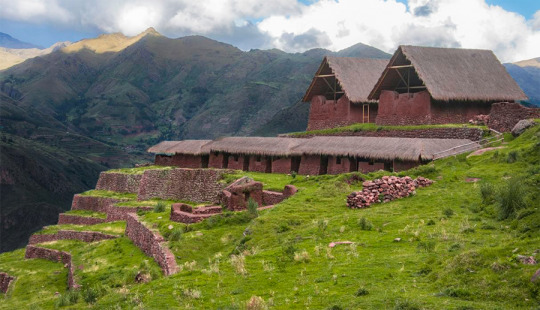The site was named in the twentieth century; He had previously been known as Kakya Qawani. Pedro de Cieza de León, in his Second Chronicle of Peru, said that the palaces were built by Viracocha, the eighth Inca ruler. Among a large number of buildings, some of stone, some of adobe, is a Kallanka (large hall) 40 m long. The water supply is an Inca built irrigation canal, filled with stones of about 800 meters.

Huchuy Qosqo was probably established as a royal estate by the Inca Emperor Viracocha around 1420 CE
The Spanish took control of Kakya Qawani in the year 1500, after the Inca Manco Revolution (approx. 1540) and the site is used as a farm. Villagers built several small reservoirs for irrigation. During their time in Huchuy Quosqo, the Spaniards demolished some other Inca structures to build the largest reservoir seen today.
Below the main site of Huch’uy Qusqu is the recently restored storehouse for meat and crops such as corn, potatoes, quinoa and dried beans. In this two-story structure, you can see the historic refrigeration storage system known as ‘conjeras’.
The settlement in the archeological ruin in Huchuy Qusqo dates back to between 1000 and 1400 CE. In the early 1400s, according to the Spanish chronicler Pedro Cieza de León, it became a real property of the semi-mythical Viracocha (c. 1410-1438), the eighth Inca ruler.
The Inca Empire did not impose the income or production of its citizens as a common practice, but rather controlled the land and labor. Thus, the Inca leaders acquired great real properties to increase their power and wealth and that of their descendants who inherited the properties. The royal properties also served as elegant rural palaces and sometimes fortresses to defend themselves against their rivals for power. Thus, the name Huchuy Qosqo, "Little Cusco", for a real property or government center modeled in the Inca capital.
To build, operate and maintain their assets, Viracocha and its descendants required a large number of workers. The citizens of the Inca empire were obliged, under the mit’a system, to contribute labor to the Empire, instead of paying taxes on their wealth or production. Mit'a impressed labor was probably found among nearby ethnic groups, although specialists and artisans could be imported.
Another Inca policy, that of mitma, was probably used to collect labor for the royal heritage. The mitmaqkuna were entire families or ethnic groups that moved to new lands in the empire or settled in enclaves among the first inhabitants of an area. The purpose was to widely distribute the different ethnic groups, thus separating potential troublemakers and reducing the possibility of organized resistance to the Incas. The mitmaqkuna were discouraged from mixing with local ethnic groups. A third source of work for the farm was the Yanakunas, the permanent servants of the Incas. The Yanakuna often reached high positions in the Empire, and as the mitma were ruled directly by the Incas. Still a fourth source of work for the royal states was aqllakuna, abducted women who lived together and produced textiles, an important source of Inca wealth, and chicha, the fermented drink consumed at parties. The Allakuna used to marry men honored for their service to the Empire.
These four sources provided the work and experience for the management of a real estate that could control thousands of acres of agricultural and grazing land, mines, textile factories and other resources and employ thousands of people. The sixteenth-century Spanish sources identify more than 40 ethnic groups found in an area of the Sacred Valley, an indication of the degree of resettlement and disruption of the population undertaken by the Incas during their reign.
Among a large number of buildings, some of stone, some of adobe, are a Kallanka (large hall), 40 m long. The water supply to the site is an irrigation canal built by the Incas, lined with stones for about 800 m.
Inca wall and agricultural terrace (anden). The Spanish took control of Huchuy Qosqo in the 1500s, after the Inca Revolution of Manco (approximately 1540) and used the site as a farm. The Incas had built several small reservoirs for irrigation. During their stay in Huchuy Qosqo, the Spanish demolished some other Inca structures to build the largest reservoir seen today.
Below the main site of Huchuy Qosqo are the recently restored qolqas stores for dried meats and crops such as corn, potatoes, quinoa and beans. In this two-story structure, you can see the historic refrigeration storage system known as "shells."
INFORMATION OF HUCHUY QOSQO TREK
This site is inaccessible by a public road and can only be accessed by a physically strenuous walk or on horseback. The two main access points on foot are from Lamay: 3 hours to a series of sharp curves, or from Tauca, Peru, about 4 to 6 hours on foot. The first third of the walk steadily increases up to a step at 4400 m, then mostly Descent, and visiting other ruins. The 2-day route from Tauca to Lamay is described in "Exploring Cusco" by Peter Frost. Several tour groups also take two-day walks or horse riding excursions to Huchuy Qosqo.
KNOW MORE
-This route starts in Ccorao, where it deviates to Patabamba and then to Quenqo, where the seven-hour hike that ends in Lamay, in the Sacred Valley begins.
-The name of Huchuy Qosqo was put in 1930 by the intellectual from Cusco, José Gabriel Cosio; but the real name is Qacya Qawarina (‘where is the thunder’).












0 comments:
Post a Comment